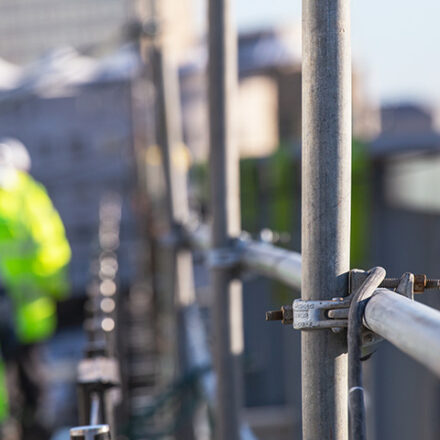5 Scaffolding Hazards To Be Aware Of
Accidents involving scaffolding on building sites are extremely common and cause serious injuries such as spinal damage or brain injury. The erecting and maintaining of scaffolding systems is subject to extensive legislation and regulations but unfortunately such accidents are still too common. Scaffolding systems come with many inherent risks such as slipping, falling, being injured by falling objects or suffering a scaffolding collapse.

Common hazards are as follows:
Scaffolding systems are subject to the Work at Height Regulations 2005. However, many falls are attributed to the lack of guardrails, improper installation of fall from height mechanisms and failure to use personal fall arrest systems when required. Lack of proper access to the scaffold work platform is another reason for falls from scaffolding.
The proper erection of scaffolding is essential in preventing this hazard. The amount of weight the scaffolding will be required to hold, including the weight of the scaffolding itself, materials and workers must be considered. Foundation stability is also a factor.
Workers on scaffolding platforms are not the only ones exposed to scaffolding related hazards. Many injuries have taken place to individuals who have been injured or killed due to being struck by materials or tools that have fallen from platforms.
Over time, parts of the scaffold may become damaged and compromise the stability of the entire structure. Such damage may render the structure unsound leading to a collapse. Routine inspections are an absolute must when working with scaffolding systems, and employees should be encouraged to report any damage that results from daily work activities.
One hazard that arises from working on scaffolding is a lack of training among the employees. If workers are not trained properly, they will be more prone to accidents and to cause accidents to fellow workers. All employees must be competent for the type of scaffolding work they are undertaking and should have received appropriate training relevant to the type and complexity of scaffolding they are working on.
Employers must provide appropriate levels of supervision. As a minimum requirement every scaffold gang should contain a competent scaffolder who has received training for the type and complexity of the scaffold to be erected, altered or dismantled. Erection, alteration and dismantling of all scaffolding structures should be done under the direct supervision of a competent person.
All scaffolding inspection must be carried out by a competent person whose combination of knowledge, training and experience is appropriate for the type and complexity of the scaffolding.
Scaffold safety starts from the ground up. Only safe work conditions and actions will prevent unnecessary injuries when working on these ever-changing structures.
If you have been involved in an accident whilst working on defective scaffolding, please contact our Bradley Wright on Bradley.Wright@edslaw.co.uk 0208 514 9000.
